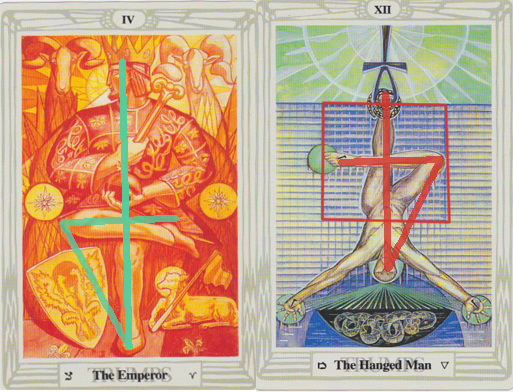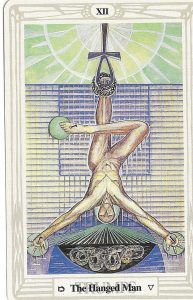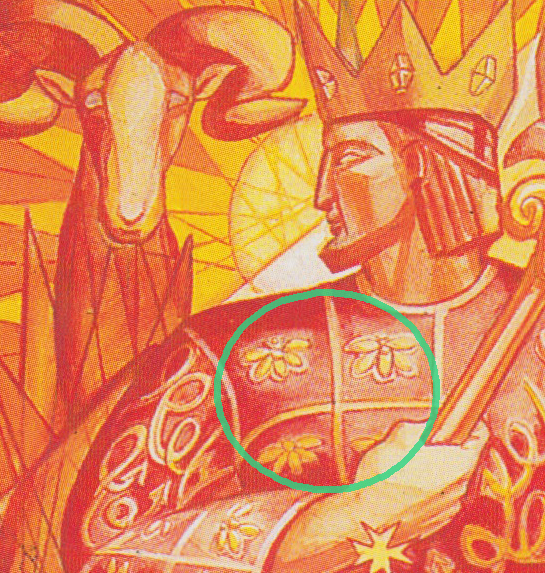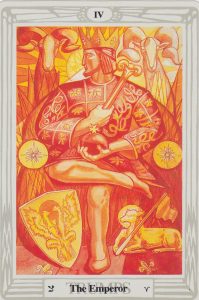When the Emperor pops up in a reading, or in your life, it can sometimes be signal of greatness. In my last post on the Emperor I described him in his despotic mood. But in his more positive aspects, Major Arcana IV – the Emperor, signifies an ability to affect change in the world. Say what you will about the Emperor and his tyrannical tendencies, dude can get things done.
In a reading, Arcanum IV can indicate the subject’s ability to realize her goals in the material world. The Emperor creates laws and policy. He motivates people and he makes stuff happen. He doesn’t mess around or get caught up in his feelings. He might destroy the whole world (notice the orb in his hands, which to modern minds might look like a cartoon bomb), but he will do what he sets his mind to do. So this can be a useful card, a powerful one, especially if you’re prone to procrastination, like moi.
The Emperor represents power, authority, and dominion/domination.
Looking around at our world, one can see that the Emperors (the presidents, the CEOs, the mob bosses, the kings, the Pharaohs and the Generals) have really have been able to accomplish a lot. They’ve conquered continents, created huge cities, launched lightening speed scientific discovery. But, as we all know, all that action hasn’t come without a price. And what annoys most of us is that it’s the little people, not the Emperor, who usually end up paying that price.
So, how do we turn this situation around?
Intuitively, most of us might think of Major Arcana III, the Empress, as being the counter thesis to the Emperor. And she can be. While the Emperor is order, she is wild abandon. While the Emperor is rule of law, the Empress is rule of nature. Masculine vs. feminine, blah blah blah. But what if it’s Major Arcana XII, the Hanged Man, who actually plays Joker to the Emperor’s Batman? Instead of “feminine” chaos being the oppositional force to the “masculine” and ordered Emperor, perhaps his counterbalance is actually HIS OWN shadow self, represented by the Hanged Man. Both the Emperor and the Hanged Man define the past Aeon, where, not only do we see the rise of tyranny, hierarchical rulers, and slave culture, but also the fetishization of death and self-sacrifice represented by Christ on the cross. Crowley says that the Hanged Man is “the card of the Dying God.” And truly, in Arcanum XII card we see a figure crucified and suspended upside down. He is Odin hanging on Yggdrasil, he is the Dying God Osiris, he is Jesus Christ.
Somehow dominator culture and death cult culture are locked in a dance together. Could it be that the Emperor’s unwillingness to integrate his own shadow is causing us all a s**t ton of problems??
Just look at the images. As you can see in the Thock deck, the Hanged Man is a complete inversion of the Emperor. They really are mirrors to one another.

According to tarot theorist, Lon Milo DuQuette:
“[The Emperor’s] arms form the triangle and his legs form the cross of the glyph of sulfur,” which, according to Crowley, “is the male fiery energy of the Universe, the Rajas of Hindu philosophy. This is the swift creative energy, the initiative of all being.”
DuQuette describes the Emperor as relating to alchemy’s “red tincture,” which is representative of action, energy and force. The Hanged Man, on the other hand is done all in blues and greens, much like Arcana III, the Empress, and represents the “white tincture.” Receptivity, meditation, the moon, water, and the alchemical element of silver. However if you look closely, not only does the Hanging Man look like the Emperor “put his thing down, flipped it and reversed it,” but the square, symbolic of the Emperor’s number 4, tellingly appears behind the Hanged Man’s “pointy end.” So, while the Emperor is one who goes out into the world slaying and conquering, his twin brother, the Hanged Man, is the ultimate symbol of introversion, stillness, and self-sacrifice. The Hanged Man reminds me of the Greek stoic philosopher Epictetus, who was born a slave in Phrygia (present day Turkey). As his story goes:
“Epictetus was once so badly tortured – for another slave’s mistake — that his broken leg did not heal properly, and he limped for the rest of his life…as his leg was being twisted, Epictetus reminded his master that a person’s leg was likely to break under such torture. [His master] ignored this, and when his leg finally broke, Epictetus said, ‘See, it’s just as I told you.’ He later said, ‘I was never more free than when I was on the rack.’ He had learned that he could control his attitude but that fate controlled his life.”
— Douglas Soccio, from Archetypes of Wisdom: An Introduction to Philosophy, p. 197

The Hanged Man often appears in readings to remind us that we are born into circumstances that are beyond our control. We can’t always use power and force to determine what happens to us. Sometimes the only thing we have control over is our own character. Our own integrity. No one else can determine our character for us, and no one can take our integrity from us. The Hanging Man is the Emperor’s shadow because while the latter gets power through exacting his will on the world, the former gets power through cultivating his own inner strength. Yet we have to strike a balance. The Hanged Man can also indicate an unwillingness to take action, an avoidance of responsibility. Thus, we should cultivate ourselves so that we have the integrity to do what is good, and not use other people’s actions as an excuse to behave abysmally. Then, as our own masters, wise and loving, we can use our will to enact change in the world for the good of everyone.
Recently a client of mine compared the Emperor and his whole story to the underlying theories of Sadomasochism
It’s an interesting idea, and it makes sense. Of BDSM people often say that the submissive is the one with the real power because hypothetically, the submissive always has the choice of whether or not to enter into or stay in the relationship, and then, once in the relationship, whether or not to obey. But what happens if you’re tied up and decide you don’t want to play anymore and the dominatrix decides she no longer wants to honor the safe word?? Who’s got the power then? You’re tied up, so. In grad school I remember one of my professors saying that it was the slave who had the real power in a society, probably referring to some Maurice Blanchot quote. But I haven’t ever been able to fully get on board with that. If we look at American history for example, it’s true that slaves as a group had enormous power within American culture, particularly in the South. Without the slave, the economic foundation of the South would collapse, as the power players well knew. American civilization was organized around slavery: regulating it, and keeping it going. So in a sense, the slave was very powerful. But they were still slaves! So while they had power as a group, and as a force in the culture, as individuals they were controlled and oppressed. Which seems pretty disempowering to me, grad school professor! I guess one might argue, like Epictetus might have, or even Sartre, that the slave always has the freedom to control her own actions and reactions. Even if her body was restrained, despite whatever oppressive force was controlling her, in her own mind she was sovereign. But to me that still feels unsatisfying.
Ultimately, the Emperor/Hanged Man dichotomy points to a philosophical problem that we as a species are still unraveling. Are we oppressing others, or are we participating in our own oppression? And if so, what are we getting out of it? And, who has been more powerful in our culture, the Emperors, with their ability to affect action in the material world through law and force, or figures like Jesus Christ, with his ability to influence the hearts and minds throughout the world through his own self-sacrifice? Personally, I am over the oppressor/oppressed story, I want us to try something new. So let’s start here, with us. How shall we begin to integrate the two forces represented by the Emperor and the Hanged Man so that we can all MOVE ON?
So, what do you think??
The more we discuss the possibilities together, the richer our understanding will be.
Let me know your thoughts comments section below!
On A Side Note: Interesting Emperor Synchronicities – Don’t Miss!

Also, the Emperor is really tripping me out right now!! For some reason, just intuitively I have been doing this whole series on the Emperor, because it just felt like the right time to do it. Now, when you work with magic a lot, s**t gets serendipitous. So, I recently went to one of white witch Maja d’Aoust’s Magic School lectures here in LA. (and p.s. if you’re around, you really should check them out because they’re awesome, and not only is she super stylish, but she also talks about a ton interesting stuff). In this case, she was talking about tyrants and Papal history and the Goddess Cybele. And while she was talking, I was thinking “this whole conversation reminds me of the Emperor card series I’m writing.” So then she was talking about bees, and how they’re the symbol of the goddess Cybele, and how the Papacy stole the symbol to put on their shield so they could harness Her power for themselves. And now I am writing about the Emperor and looking more closely at the card and I notice there are BEES all over his royal armor, AND, two fleur de lys at the bottom, the design of which Maja was saying was based on the bee. So I feel that this is yet another a signal that right now, we’re really witnessing a showdown between the resurgent goddess and the, at this point corrupted, patriarchal tyranny. On a positive note, and another synchronistic one, only just last night I was reading a book about Jung and the Tarot, which said that the number four, the Emperor’s number, represents completion, which tellingly, is also the name of the 4 of Wands in the Thoth deck (as I recently discussed, here).
But what’s really interesting is that Jung discovered (according to Hamaker-Zondag) that when people with mental problems produced artworks with fourfold structures in the drawings, it usually meant that, “the way to healing had been taken and the psyche was once more in a position to make sense of itself.” So, from that we can extrapolate: the resurgence of the symbolic essence of four, the rise of the Emperor in our culture, both as an image and as a series of tyrannical guys, might indicate that in our collective subconscious we have already found a way to heal and make sense of ourselves as a species. Keep your fingers crossed.
DuQuette, Lon Milo. Understanding Aleister Crowley’s Thoth Tarot. 2003. Weiser Books. Digital Book.
Hamaker-Zondag, Karen. Tarot as a Way of Life: A Jungian Approach to the Tarot. 1997. Samuel Weiser, Inc. Print.
Soccio, Douglas. Archetypes of Wisdom. 2012. Cengage Learning. Print.
Thank you to Malisa Humphrey, who inspired me to write this post.

